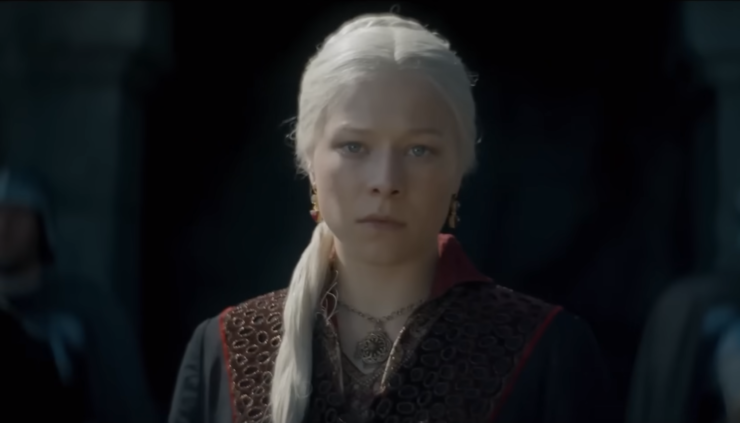Episode 7 is a masterful, edge-of-your-seat bottle episode where all the major characters wrestle with grief, dread, and the generational trauma that has spread from Alicent and Rhaenyra to their children. Nearly the entire episode is spent in a pair of lengthy scenes that have the entire cast on screen, roiling with tension, hatred, and frustration. As we move towards the end of the season, we’ll talk about more changes from the source material, most of them for the better, and the ways in which House of the Dragon continues to cleverly introduce intriguing details from Martin’s extensive world.
The Title
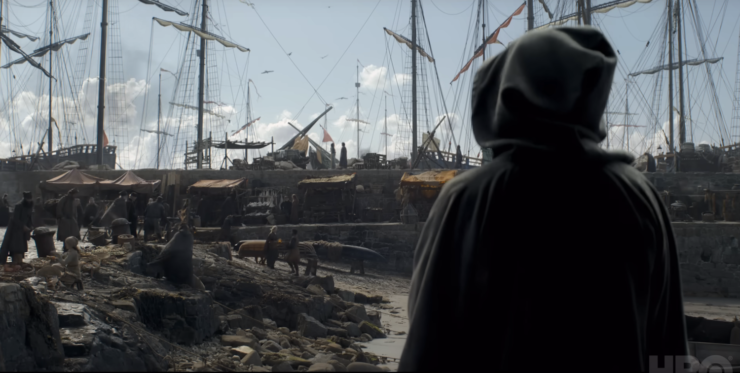
Episode 7 is entitled “Driftmark.” Obviously, this is the name of the island which the Velaryons call home, as well as the name of their former castle. The Velaryons now reside in their second castle, High Tide, built with the spoils of Corlys Velaryon’s (Steve Toussaint) famous nine voyages on a spit of land only accessible to the rest of Driftmark when the tide is out. Driftmark also supports two towns, (one for each castle)—Spicetown and Hull—alongside numerous shipyards, making it the ideal base for the Royal Navy. Driftmark’s physical proximity to Dragonstone also mirrors the close ties between the Houses Velaryon and Targaryen. Not only do both claim ancestry from Old Valyria, but the nearness of their seats means that the dragons that roost on Dragonstone are frequent visitors to Driftmark.
This episode takes advantage of the locale, not just as a central set-piece where nearly all of the show’s characters can gather for a pressure cooker of a funeral reception, but as a gorgeous setting whose forlorn stretches of coast and wind-ravaged dunes convey the yawning emptiness of the mourners, all reckoning with uncertain futures and sudden losses. The longing stares across the Narrow Sea from Driftmark also remind us of the foreignness of both the Targaryens and Velaryons. The home that provides them with a common culture is long gone and across the sea. They share some near-relationship to Westeros but are not a part of it—islands off the coast, drawn back across the sea.
Unreliable Narrators: The “Deaths” of the Velaryon Siblings
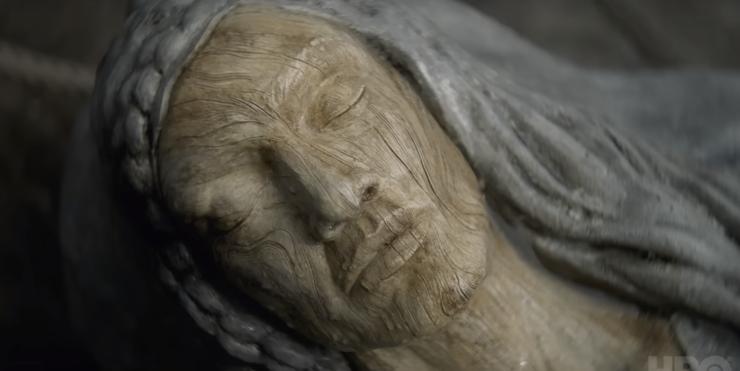
At the historical distance with which Martin writes Fire & Blood, Archmaester Gyldayn has little insight into the deaths of Laena (Nanna Blondell) and Laenor Velaryon (John Macmillan). In the book, both die as part of the “Red Spring,” a year of untimely, unrelated deaths which reshape the political landscape. There is more nuance and care taken with their stories here in the show, as well as one stunning reversal seemingly designed to fake-out book readers. We will begin Laena’s death, which occurred last episode and is the more recognizable of the two when translated onto the screen.
Gyldayn writes of Laena’s death:
A day and a night of labor left Laena Velaryon pale and weak, but finally she gave birth […] but the babe was twisted and malformed, and died within the hour. Nor did his mother long survive him […] After three days of delirium, Lady Laena passed from this mortal coil” (Fire & Blood 378)
Buy the Book
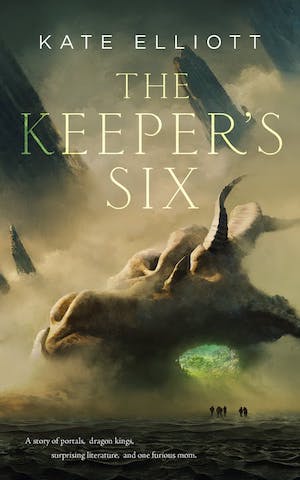

The Keeper’s Six
In this case, the basic elements are preserved: Laena dies as a result of complications from pregnancy. But where the book’s account serves as another example of the violence that women face under the patriarchy, the show expands her death into a moment of agency and a reflection of Daemon’s (Matt Smith) willingness to put freedom over legacy. He does not order a fatal cesarean like Viserys (Paddy Considine) did in episode one, and Laena chooses a quick and dignified death by dragonfire rather than a slower, tortured demise which would reduce her final moments to that of a broodmare in the game of thrones. It’s a subtle change that reverberates wonderfully against the book’s distant and casual cruelty… but it’s nothing compared to the changes they make with Laenor.
In Fire & Blood, Laenor is reported to have been “stabbed to death by his friend and companion Ser Qarl Correy […] The circumstances of the murder remain a mystery […] Septon Eustace […] declares jealousy the motive for the slaying […] Mushroom, as always, favors the sinister theory, suggesting that Prince Daemon paid Qarl Correy to dispose of Princess Rhaenyra’s husband” (Fire & Blood 379). Once again, the show chooses to carefully thread the needle by mixing and matching Gyldayn’s sources and placing Daemon and Qarl (Arty Froushan) at the center of the Laenor’s apparent death. The showrunners even appear to expand upon this version of events with a cruel twist, making Rhaenyra (Emma D’arcy) equally responsible for the murder just hours after reaffirming how much she cares about her husband’s happiness. It’s a clever little ruse that seems intended to fake-out book readers: adding a layer of horror before pulling a bait and switch and giving one of the show’s few decent characters a chance to live a full and fulfilling life far away from the poisonous demands of the Iron Throne.
Ever since the death of Joffrey Lonmouth (Solly McLeod) in episode five, there has been a worry lurking in the pit of my stomach about how the show will handle the death of its second queer character in a season—this one played by an actor of color. On the whole, the showrunners are doing a fantastic job of making the necessary changes to keep to the plot of the original while minimizing some of its less palatable tropes and giving its minor characters the care they deserve. It is unlikely that we will see Laenor again in this series (though the fact that a number of plot-points going forward will deal with the Free Cities opens up a couple of possibilities for where he could show up) but it is good to know that, even on a show as ruthless as House of the Dragon, a deserving character occasionally gets some semblance of a happy ending.
The Blacks and the Greens
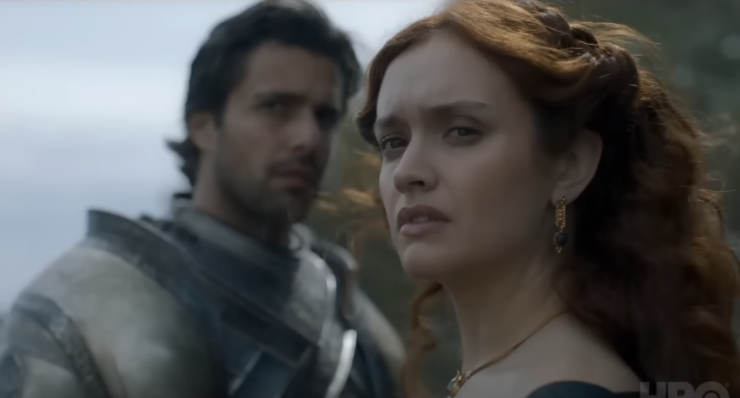
As the succession crisis ramps up between Rhaenyra and Alicent (Olivia Cooke), we should look to the thematic color coordination that the show has preserved from the books as well as recontextualized. The full title of the 2013 novella that forms the backbone of the series is The Princess & The Queen; or The Blacks and the Greens. The subtitle refers to a banquet held in honor of Viserys and Alicent’s 5th wedding anniversary. At that feast, Alicent dresses in green and Rhaenyra dresses in black, leading to members of their loyalist factions referring to themselves as “Blacks” and “Greens.” Obviously, Alicent’s dress at Rhaenyra’s wedding already provided part of this central conceit, with Larys articulating a new bit of lore for the show where House Hightower uses wildfire to signal the calling of the banners.
Given the events of this episode—including Rhaenyra referring to Alicent’s loyalists as “the Greens”—it is unlikely the show will return to the idea of a banquet where the dresses become symbolic banners under which competing factions are formed. But the show has been choosing to dress Alicent’s children in green and Rhaenyra’s in Targaryen red and black. We haven’t yet gotten an in-world explanation for Rhaenyra’s sartorial choices (though there is reason to believe we will by the end of this season), but there are certainly some key resonances with the color black on which the show can draw.
Obviously, the Targaryen sigil is a red, three-headed dragon on a black field which makes both colors important to Targaryen identity. But there is also Balerion, the Black Dread who is the first of the Targaryen dragons post-exile as well as the mount for Aegon the Conqueror and (briefly) for King Viserys.
The Valyrian steel sword of the Targaryen kings, Blackfyre, is likely named for Balerion, given that, in Martin’s original books, the magical fire that dragons breathe is color-coordinated with their scales. Thus, black-scaled Balerion breathed gouts of black flame. (I’m always on the fence about this missing detail, in part because it so clearly flags dragons as magical creatures whose fiery breath is anything but natural. That said, it might be hard to pull off on-screen without looking a little silly).
Blackfyre initially signified the legitimate and primary Targaryen line, just as Dark Sister (as mentioned in my explainer for episode six) signifies a troublesome and ambitious lesser line. A century or so after the events of House of the Dragon, however, the blade will be taken up by a legitimated Targaryen bastard, Daemon Waters. He goes on to rename himself Daemon Blackfyre and start the first of four Blackfyre Rebellions across the next fifty years. Sons of House Blackfyre are among the exiled Targaryen princes mentioned in the last article and use the Targaryen colors in reverse—a black dragon on a red field. Even if Rhaenyra doesn’t isn’t given a clear reason for her appellation in the show, she resonates as a spiritual (and literal) ancestor of House Blackfyre and its penchant for walking the line between legitimacy and revolt.
Odds and Ends
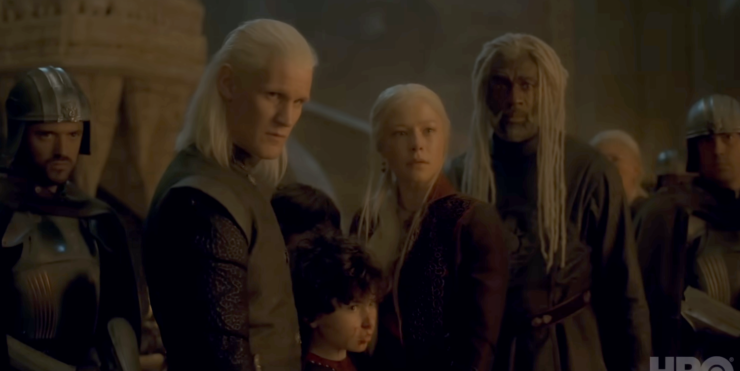
The Merling King
During the funeral service for Laena, Vaemond Velaryon (Wil Johnson), intones that they will commit her body to “the dominion of the Merling King.” The Merling King is a sort of folk-deity worshiped by sailors and fisherman on both sides of the Narrow Sea. Not part of any formal religion, he is represented in the books as a sort of Triton figure—a bearded merman with a trident. There are a few references to the Merling King scattered throughout the various novels and concordances—a rumored witch, Ursula Upcliffe who claimed to be his bride; a representation on the banners of House Manderly of White Harbor; some spires of rock in Blackwater Bay called the “Spears of the Merling King”—but the most interesting connection to the Velaryons comes from a rumor that the Driftwood Throne, the Lord of the Tides’ literal seat, was a gift from the Merling King after a pact was made between the god and exiled Valyrian merchant princes. That said, being Westerosi Lords from Old Valyria, there is never any indication in the books that the Velaryons worship anyone but the Seven (or perhaps the gods of their shattered homeland).
Helaena Targaryen
The last two episodes have each given us a scene with Alicent’s second child and only daughter, Helaena Targaryen (Evie Allen). In the books, we are not told much of Helaena until later in the narrative. While she eventually succumbs to madness, the show is portraying her as seemingly neurodivergent as well as possessed of prophetic powers. In the previous episode, she claimed that her brother, Aemond, would need to “close an eye” before obtaining a dragon and this episode sees her repeating “hand turns loom; spool of green, spool of black; dragons of flesh weaving dragons of thread” in apparent reference to the looming crisis between the Blacks and the Greens. Some have theorized that her episode six characterization of a millipede’s final segment having no legs might even be in reference to Bran Stark, the final king of Westeros in the timeline we have access to. Whatever the show intends to do with Helaena Targaryen, these brief glimpses have been more interesting than her original characterization and might even give us more of the magic and prophecy that the original series was sorely missing.
***
Personally, “Driftmark” is my favorite episode to date. It takes its time giving us all the simmering tensions in the Targaryen/Velaryon/Hightower clan only to have the hostility explode in a fantastic scene that sees all the rancor between Rhaenyra and Alicent finally boil over. The show is doing an excellent job of fleshing out Alicent Hightower especially, who remains sympathetic and tragic even as her paranoia drives her to more extreme measures. It’s also been efficient in its characterization of the Targaryen and Velaryon children, who only get these last two episodes to establish themselves before another time jump gives us the actors who will portray them as young adults (and likely through the end of the series). Only three episodes remain! What did you think? Did you enjoy the powder keg of Driftmark? How do you feel about the changes from the source material? How great does Vhagar continue to be?
Tyler Dean is a professor of Victorian Gothic Literature. He holds a doctorate from the University of California Irvine and teaches at a handful of Southern California colleges. He is the author of “Distended Youth: Arrested Development in the Victorian Novel” and his article “Exhuming M. Paul: Carmen Maria Machado and Creating Space for Pedagogical Discomfort” appears in the most recent issue of Victorian Studies. He is one half of the Lincoln & Welles podcast available on itunes or through your favorite podcatcher. His fantastical bestiary can be found on Facebook at @presumptivebestiary.










